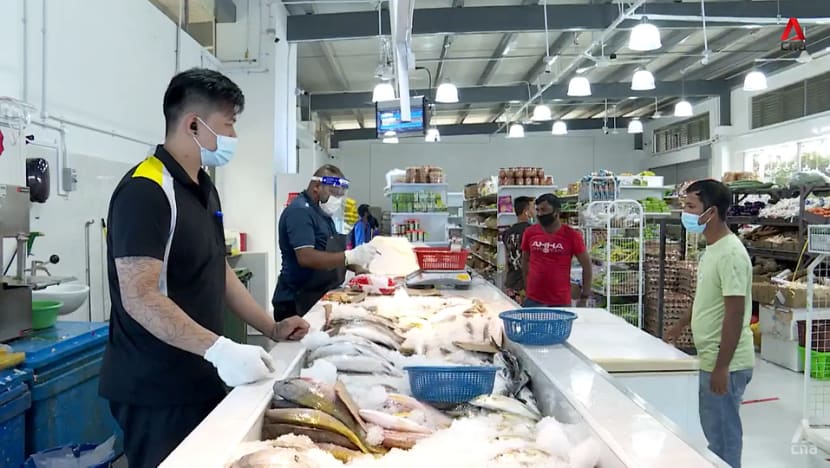A year since COVID-19, dorm life leaves migrant workers still hoping for better
Life has not changed much for some workers who are unable to share communal facilities, must still eat in crowded rooms and face restrictions outside the dormitories too. They share their stories with the programme Talking Point.

Dinner time in one of the dormitories.

This audio is generated by an AI tool.
SINGAPORE: Their dining area remains empty — the workers are not allowed to eat there. And so Omar Sakib must have his meals in his room instead, with his 11 other roommates.
They cannot “gather” in the dormitory corridors either. “We’re only allowed to go to the toilet, use the toilet and come back to our room,” he said.
“There are so many restrictions still in my dorm, so I feel like I’m in lockdown.”
It has been nearly a year since COVID-19 started to hit foreign worker dormitories, and about six months since most of the workers could return to work. But for some of them, life has not changed much.
Sayed, for example, lives in a smaller room than the one in his previous dormitory. There are 10 of them there, but “still 16 beds inside”, which means a lack of space. “It looks overcrowded,” he said.

Space, or a lack thereof, is not all that gets to Richard Rosales; he is also “very sad” that he “can’t do anything”.
“(It’s) like (being) in jail, just eating, watching a movie and then … lying in bed, resting,” he said. “That’s why it’s very hard for us.”
Over the course of three months, the programme Talking Point contacted migrant workers for their stories, videos and vlogs — for an unvarnished look at their lives — and finds out the impact that coronavirus infection controls have had on them.
RESTRICTED ACCESS
When the first dormitories were declared isolation areas last April, Singaporeans soon got to learn of migrant workers’ dormitory life, with more than 320,000 of them living in dormitories.

Using their phones, workers took CNA Insider into their quarters and talked about their fear, boredom, cluttered conditions and the series of support measures that needed to be stepped up for them.
Being able to get food in a timely manner was just one of the challenges. And it still is for some.
“While we’re collecting our food from catering, (there’s) a long queue,” Sakib, who has lived in Singapore for 11 years, said in a video he sent to Talking Point.
Over at Westlite Toh Guan, a 7,800-bed dormitory, there are now segregation measures such as barricades, fencing, wire mesh, several SafeEntry scans and no-entry zones.
To minimise congestion, workers can leave their rooms for work only at designated times. “I can go outside only when it’s time for my transport (to arrive),” said Kotha Suresh, one of the residents.

It is “very important” to have measures like these that reduce crowding and “co-mingling” of workers in order to “mitigate the infection rates”, said Kong Chee Min, chief executive officer of Centurion Corporation, which owns the dormitory.
“We have multiple release points in this dormitory so as to ensure that the residents go in and out of the dormitory swiftly and also go through the necessary checks.”
After work, when he returns to his room, Suresh can barely do much. “(Watch) movies, play games (on my) phone, call home — just this,” he cited.
Before the pandemic, he sometimes met his friends during his free time, as many other migrant workers used to do but not any more. “I miss (it), but (I have) no choice,” he said.

What he is allowed to do, however, is cook his own dinner to eat in his room. And recently, the gym in his dormitory reopened while communal sports like sepak takraw have resumed.
But restrictions differ across dormitories. Some are more stringent than others, as Sakib has experienced. “We aren’t really able to (use) all those facilities, like cooking and the sports zone or (the field),” he lamented. “The restrictions are still there.”
MOVEMENT CONTROLS OUTSIDE
Strict rules for migrant workers do not only apply within the dormitories, but also on their one day off a week.
Amid the pandemic, dormitory residents can only go to purpose-built recreation centres on their rest days. These centres have amenities like food and beverage outlets, a barber, remittance service and a supermarket.
To be eligible for a visit, a worker must come from a dormitory cleared of COVID-19 and must produce a negative swab test.

He must also apply for an exit pass and is allowed to go only to a recreation centre assigned to him.
Kavikumar, who typically goes to the Cochrane Recreation Centre in Sembawang once a week, said he applies for the pass at least one or two days beforehand.
The issue for him and other workers, however, is they get to spend only three hours outside their dormitory to run errands.
“Of course (it’s) not enough. Because normally, we’re only allowed (to go to) work and come back to (the) dorm,” he said. “I’m also only allowed (at the) recreation centre. I’m not going to other places.”
WATCH: Still “feels like jail”? Life for foreign workers nearly 1 year on in Singapore (4:17)
He has relatives working in Singapore, but meeting them is “very difficult” to arrange now. “These are the things I really miss,” he said. “But (we have) no choice.”
It is hard for workers to maximise the time they have outside also because it includes travelling time.
“Our company lorry takes (us there) and brings (us) back,” cited Sakib. “It takes one and a half hours. (With) one and a half hours left, I can’t make time to meet friends and have fun.”
So some workers even choose to stay in on their rest day. And all the restrictions are taking a toll. “It’s depressing for all the migrant workers to follow all (these) rules,” said Sakib.

Rashed Mohammad, a safety co-ordinator on his work site, has seen the effects because his job is “to take care (of) all my (workers)”.
“Every single person has a different feeling,” he said. “A few of them say they’re very bored because … they can’t go on home leave, so they miss their family. A few of them say they’re not so good, mentally.”
Until early this year, he lived in a dormitory. But as it was far from his current work site, his company moved him to private accommodation, where he says life is better.
He still faces restrictions, however, as workers like him should only leave their residences for non-work purposes on their assigned rest days.
“I don’t go around (to a) shopping mall or anything. I just go out for my essentials, to buy food,” he said. “We don’t have any approval to go outside as before.”

Asked how he felt, he replied: “It feels something like (being) mentally depressed, because you know that we’re people — we also need to refresh our mind.”
A DIFFERENT FUTURE?
Advocacy groups have pointed to the prolonged confinement and job uncertainties affecting many migrant workers in Singapore, so much so that a government task force, named Project Dawn, was set up in November to enhance mental care support for them.
Its efforts include equipping front-line officers to detect dormitory residents who may be showing signs of stress. The workers are hoping, however, that the authorities also address the issues they face on the ground. And now, changes are afoot.
For example, more workers will be able to cook for themselves.
“There are dorms that have en-suite cooking facilities. Now those that have communal cooking facilities were where we had the restriction,” noted Martin Koh, deputy chief of plans at the Ministry of Manpower’s (MOM’s) Assurance, Care and Engagement Group.
“But we’ve already lifted it, and we’ve invited dorm operators to apply to MOM so that we’re satisfied that the safe management measures are all in place.”

He also appealed for operators to be given “some time” to make space in the workers’ rooms. “We’re working very closely with the dorm operators to make sure that we continue with this de-densification effort,” he said.
While some dormitory residents have mentioned that they are not allowed to take public transport, he clarified that this is only for travel to and from work.
“When it comes to peak hour traffic, the risk of transmission is the highest. And when we have large groups of workers going out to work using public transport, that’s where we introduce this transmission risk in both directions between the dorm workers as well as the community,” he said.
“When it comes to other activities, … while we strongly encourage employers to arrange transport, we allow (use of) public transport because the transmission risk is a lot lower.”
WATCH: The full episode — How are Singapore's migrant workers coping with COVID-19 restrictions, one year on? (23:50)
He does not see this restriction changing “for as long as COVID-19 is with us”. But he indicated “positive changes this quarter” in terms of increasing “the frequency of visits to the recreation centres and for longer”.
With all the robust measures in place, if there is a silver lining to the pandemic, it is that it has accelerated plans to improve migrant workers’ living conditions.
Seven Quick Build Dormitories have been launched and more will be ready later this year, totalling 25,000 bed spaces. While these are a temporary measure, they will serve as a guide to more permanent housing solutions for Singapore’s migrant workers.
They have more spacious rooms, each with an en-suite bathroom and five single beds — spaced at least a metre apart — compared with a typical dormitory where up to 16 workers share a room.

The new dormitories also have larger communal spaces such as kitchens, and amenities like a minimart.
So a year after COVID-19 struck — with more than 150,000 migrant workers in dormitories testing positive in polymerase chain reaction or serology tests — they are getting a living environment that is “more resilient to infection”, Koh noted.
But what they would also like is to rejoin the community, “even once a month” as Rosales pleaded.
Sakib added: “I hope our restrictions (are lifted), and we’re given the space to release our stress.”
Rashed knows what he misses. “I hope … we can go around Singapore and eat at the hawker centre and … go watch a movie as before,” he said.
Watch this episode of Talking Point here. The programme airs on Channel 5 every Thursday at 9.30pm.
Editor’s note: This story has been updated to clarify that the Ministry of Manpower does not allow dormitory residents to take public transport to and from work even during off-peak hours.

















